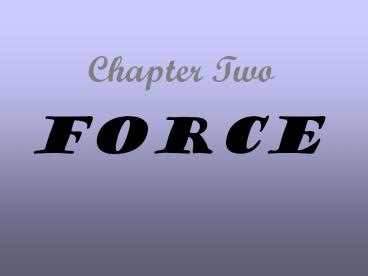Chapter Two - PowerPoint PPT Presentation
Title:
Chapter Two
Description:
Chapter Two Force How does this relate to the last chapter on motion? Forces can cause motion But what is Force? Force is a push or a pull. Net Force total ... – PowerPoint PPT presentation
Number of Views:61
Avg rating:3.0/5.0
Title: Chapter Two
1
Chapter Two
- Force
2
Forces
3
How does this relate to the last chapter on
motion?
4
What causes an object to start moving, stop
moving, or change direction?
5
Force
6
Forces can cause motionBut what is Force?
7
Force is a push or a pull.Net Force total
force on an object
8
Balanced forces do NOT move objects (objects
stay in the same place)
9
Unbalanced forces move objects
10
Forces do not cause motion, forces cause
acceleration.
11
Inertia tendency of an object to resist change
in motion
12
Mass- amount of matter in an object
13
(No Transcript)
14
Newtons 1st Law of MotionAn object at rest
will remain at rest, and an object moving at a
constant velocity will continue moving at a
constant velocity unless acted upon by an
unbalanced force.(Law of Inertia)
15
Newton's first law of motion declares that a
force is not needed to keep an object in motion.
Slide a book across a table and watch it slide to
a rest position. The book in motion on the table
top does not come to a rest position because of
the absence of a force rather it is the presence
of a force - that force being the force of
friction - which brings the book to a rest
position. In the absence of a force of friction,
the book would continue in motion with the same
speed and direction - forever! (Or at least to
the end of the table top.) A force is not
required to keep a moving book in motion in
actuality, it is a force which brings the book to
rest.
16
(No Transcript)
17
(No Transcript)
18
(No Transcript)
19
(No Transcript)
20
(No Transcript)
21
(No Transcript)
22
Think of a bowling ball as your particle. If it
is just sitting there and nobody bothers it, it
would remain sitting there. And if the bowling
ball is rolling on a straight and level surface
and nobody bothers it, it would keep right on
rolling in a straight line, right?
23
Newtons 2nd Law of MotionThe force on an
object is equal to the product of its
acceleration and mass. Ie. Force Mass
Acceleration
24
If the amount of force is increased, then the
amount of acceleration will also increase.
However, the more mass the particle has, the more
force is required to accelerate it.
25
Think of a bowling ball sitting on a level
surface as your particle. If someone pushes on
the ball, it will move in the direction it is
pushed. It also takes more pushing to move a
heavier bowling ball.
26
Newtons 3rd law of MotionIf one object exerts
force on another object, then the 2nd object
exerts a force of equal strength in the opposite
direction on the first object.
27
"For every action, there is an equal and opposite
reaction."
28
(No Transcript)
29
Have you ever watched a game of billiards? When
one ball strikes the other (action), it meets
with a force from the other ball (reaction).
After the collision, the second ball is set in
motion and the first ball slows down or stops,
doesn't it? The momentum of the first ball is
transferred to the second ball, and vice-versa.
30
(No Transcript)
31
The size of the force on the air equals the size
of the force on the bird the direction of the
force on the air (downwards) is opposite the
direction of the force on the bird (upwards).
32
(No Transcript)
33
Momentum Mass Velocity
34
Smile Youre done?































